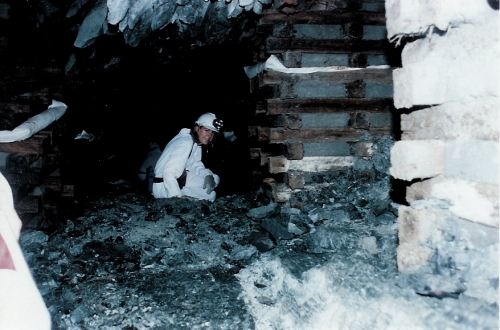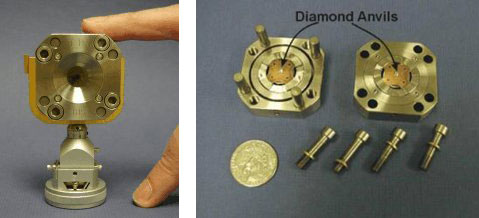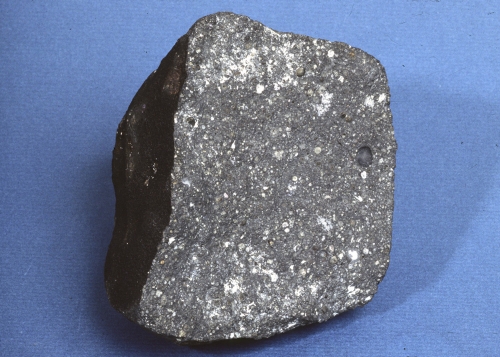What will scientists study when they get to the mantle
But How Do We Know What's Downwardly At that place? / Reading & Give-and-take Assignment
![]() Print
Print
Observing the Interior
The deepest boreholes only go several kilometers into the Earth. A mine is the deepest place a person can get into the Earth (see Eliza, below) and while it's pretty incredible down there, even being deep in a gold mine does not offer much data about what the Earth is like hundreds or thousands of kilometers below the surface.

Eliza at about 3.5 km depth in a gold mine south of Johannesburg, Southward Africa.
Source: South. Webb
Seismic Waves
Since we can't go to the eye of Earth, we accept to rely on indirect observations of the materials of the interior. These observations mostly come from seismic waves. When an earthquake occurs, free energy is radiated from the location of the earthquake in waves that travel through the Earth and arrive at seismometers at some distance from the source. The speed of these waves through the Globe is controlled past the properties of the material that the waves pass through. By measuring the fourth dimension it takes for diverse waves to get from an earthquake to a given seismometer, scientists can back out what the material properties must accept been like along the path taken by the moving ridge.
Cool historical side note: The major boundaries of the Earth's interior were discovered by seismologists.
In 1909, Andrija Mohorovičić, a Croation seismologist, discovered the boundary betwixt the crust and the mantle by observing the sudden increment of seismic waves as they passed from the crust to the mantle. Because of the sudden jump in moving ridge velocity, he was able to infer that there must be a change in the composition in the rocks at that depth. The boundary between the crust and the mantle is generally known as the "Moho" since most scientists had problem finding the special characters needed to write Mohorovičić's entire last name correctly using a western keyboard. ha ha, merely kidding. "Moho" is but used considering it is a shorter give-and-take. In 1912, Beno Gutenberg used observations of the sudden drop in P moving ridge speed together with the observation of a "shadow zone" in which direct P and Due south waves do non arrive at seismograms a certain altitude from the source (more than on this afterwards in this lesson) to calculate that the depth of the cadre-mantle purlieus must be at near 2900 km. In 1936, Inge Lehmann observed a second "shadow zone" within the cadre itself to notice the purlieus between the inner cadre and the outer core.
Laboratory Measurements
Seismic waves aren't the only style scientists try to effigy out the properties of the interior of the Earth. Some geophysicists try to simulate conditions in the deep World by heating and squeezing probable mineral assemblages to come across how they bear under the intense pressure and temperature regimes of the lower mantle and cadre. One way this is done is in a diamond anvil prison cell. The mineral aggregation of interest is squeezed between diamonds and sometimes simultaneously heated with a light amplification by stimulated emission of radiation in an attempt to achieve the enormous temperature and pressure level deep in the Globe. People are oft impressed by the size of a diamond anvil apparatus, and I don't mean considering it is so large! Check out the photos of 1 below.

Diamond anvil cell for conducting high-pressure mineralogic experiments assembled (left) and disassembled with a Usa quarter for scale (right).
Photos by Mark Fortney of Virginia Tech
Carbonaceous chondrites
Geochemical theory also predicts the composition of the mantle and core. Meteorites give united states of america information about the composition of the early on solar arrangement, and many of them have been dated to be older than the oldest crustal rocks on Earth. Carbonaceous chondrites, similar the one in the photo below, are a special form of meteorites. Geologists retrieve that these are representative of the composition of the whole Earth. So, by analyzing the elements independent in one of these meteorites, nosotros should be able to back out the composition of our planet. This is one of the ways we've guessed at the composition of the core. Meteorites tell u.s.a. that the Earth should have a lot more fe and nickel than what we have observed in the crust. It tin can't go in the mantle considering the seismic wave speeds aren't fast enough and besides we don't detect iron and nickel coming out of volcanoes that evidently have a deep mantle source. Therefore, the missing fe and nickel must be in the cadre.

Allende, Mexico, carbonaceous chondrite. This chondrite contains chondrules (notation the round cavity left by the removal of a large chondrule). Allende, similar many carbonaceous chondrites, contains calcium-aluminum-rich inclusions (CAIs). Unlike chondrules, which are round and composed mostly of silicate minerals like olivine and pyroxene, CAIs are predominantly white to calorie-free greyness in color, irregularly shaped, and rich in refractory (high- temperature) minerals like melilite and spinel. They are believed to predate chondrules by at least two million years. This specimen is ~ 11 cm from left to right.
Reading and Discussion Assignment
Read these two papers:
- Dubrovinsky, L. & J. F. Lin (2009). Mineral Physics Quest to the World's Cadre, Eos 90, pp. 21-22.
- Anderson, D. L. and S. D. King Driving the Earth machine? Scientific discipline 346, 1184 (2014); DOI: 10.1126/science.1261831
The Dubrovinski & Lin commodity summarizes the state of the art amidst mineralogists who are studying the composition of the deep Earth. The Anderson & King paper offers a perspective that the asthenosphere is hotter than nosotros idea and may be the source of non-subduction-zone volcanism. When y'all read them, think near the following questions for word:
Discuss in Canvas, starting with these questions
- What are the best guesses almost the pressure and temperature at the center of the Earth? How did scientists arrive at these estimates?
- What does "seismic anisotropy" hateful? What does the observation of seismic anisotropy in the inner core tell us about its structure?
- Look at the left panel of Figure 1 in the Dubrovinsky and Lin paper and compare it to the figure in the Anderson & King paper. How can y'all reconcile these two images?
- Explicate the arguments against a deep mantle source for "plume volcanism" made past Anderson & Male monarch.
Grading criteria
You lot volition be graded on the quality of your participation. See the grading rubric for specifics on how this assignment will be graded.
Source: https://www.e-education.psu.edu/earth520/content/l4_p3.html
0 Response to "What will scientists study when they get to the mantle"
Postar um comentário